isadora's dance
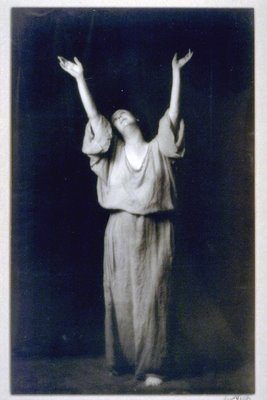
isadora duncan credited seeing the japanese prints with women in kimono as her inspiration to loosen, to free, her clothing and her dance.
Labels: dance, fashion, isadora duncan

Labels: dance, fashion, isadora duncan
 max kurzweil, a founding member of the vienna secession, lived a charmed life, filled with love, sunlight, and the sparkling waves. though he may have been outshone by his fellows (klimt, moser), he was an enthusiastic contributor to the movement's journal ver sacrum (sacred spring), loved teaching as well as being a father.
max kurzweil, a founding member of the vienna secession, lived a charmed life, filled with love, sunlight, and the sparkling waves. though he may have been outshone by his fellows (klimt, moser), he was an enthusiastic contributor to the movement's journal ver sacrum (sacred spring), loved teaching as well as being a father. kanae yamamoto was an innovator as well, being a pioneer in the sodaku hanga movement in which unlike the generations before him, the artist himself carried out the whole process of creating the prints, from cutting the wood to doing the printing. he also joined with others in the movement to start their own magazine, hosun (little things).
kanae yamamoto was an innovator as well, being a pioneer in the sodaku hanga movement in which unlike the generations before him, the artist himself carried out the whole process of creating the prints, from cutting the wood to doing the printing. he also joined with others in the movement to start their own magazine, hosun (little things).Labels: kanae yamamoto, max kurzweil
 "Because people cannot see the color of words, the tints of words, the secret ghostly motion of words;
"Because people cannot see the color of words, the tints of words, the secret ghostly motion of words; would accuse Hearn of exoticizing Japan, but as the man who offered the West some of its first glimpses into pre-industrial and Meiji Era Japan, his work still offers valuable insight today." (from wikipedia)
would accuse Hearn of exoticizing Japan, but as the man who offered the West some of its first glimpses into pre-industrial and Meiji Era Japan, his work still offers valuable insight today." (from wikipedia)Labels: arthur wesley dow, lafcadio hearn
 one thing that continues
one thing that continues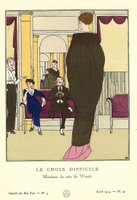 to strike me is how similar
to strike me is how similar 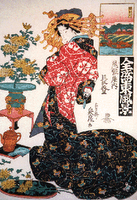 the silhouettes of women's clothing during the fin-de-siecle
the silhouettes of women's clothing during the fin-de-siecle period to the japanese silhouettes of that and previous eras.
period to the japanese silhouettes of that and previous eras.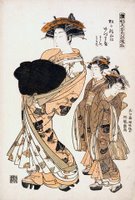 if you sort of squint or see them
if you sort of squint or see them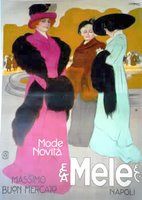 in just thumbnails, it's really hard to tell just which you're seeing, other than, perhaps,
in just thumbnails, it's really hard to tell just which you're seeing, other than, perhaps, 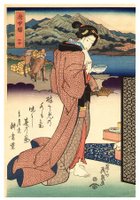 the use of pattern
the use of pattern on the japanese fabrics.
on the japanese fabrics.Labels: aubrey beardsley, boutet de monvel, Eisen Ikeda, fashion, sencho, Shuntei Miyagawa
 a gentleman on livejournal asked if anyone knew the significence of ginkgo leaves because they were used quite a lot in art nouveau architecture. his web site features the best of 40 years of taking 2500 photos of these buildings. it's an extraordinary place(s) to visit.
a gentleman on livejournal asked if anyone knew the significence of ginkgo leaves because they were used quite a lot in art nouveau architecture. his web site features the best of 40 years of taking 2500 photos of these buildings. it's an extraordinary place(s) to visit.

 unlike the nasturtium, however, morning glories are plentiful in both cultures, though in japan they are very likely to be found in poetry known as death haiku. along with the cicada, and dew in the grass, the morning glory appears as a reminder of both life's beauty and life's brevity.
unlike the nasturtium, however, morning glories are plentiful in both cultures, though in japan they are very likely to be found in poetry known as death haiku. along with the cicada, and dew in the grass, the morning glory appears as a reminder of both life's beauty and life's brevity.
 (the first image is by ide gakusui; the second is margaret jordan patterson, third is katei taki, and last is g. lebart.)
(the first image is by ide gakusui; the second is margaret jordan patterson, third is katei taki, and last is g. lebart.)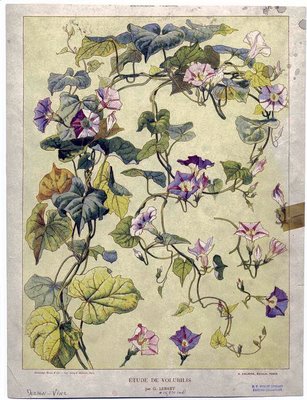
Labels: G. Lebart, haiku, ide gakusui, katei taki, kato, margaret jordan patterson
 one thing that i have found
one thing that i have found is that while nasturtiums seem to be
is that while nasturtiums seem to be they don't seem to exist at all in
they don't seem to exist at all in this is the only case of this i've found
this is the only case of this i've found (voysey is the first one, then G. Lebart, then oscar droege, and lastly, walter j. phillips.
(voysey is the first one, then G. Lebart, then oscar droege, and lastly, walter j. phillips.Labels: G. Lebart, Maurice Verneuil, oscar droege, walter j phillips
 how interesting. this image, by bairei kono from an 1892 manga, is clearly part of this "set"!
how interesting. this image, by bairei kono from an 1892 manga, is clearly part of this "set"!Labels: bairei kono
 trying to make this into a narrative (much as i tend to do with my own life), and, like my life, it just isn't. so this blog now becomes randomized. there's just so much, so much beauty, so much irony, so much of dreadful interest, that to try to make it orderly is to create a deceit. it's complex and complicated and redundant and contradictory, and so it is. when, if, connections appear i'll do my best to notice. feel free, if you notice, to let us know.
trying to make this into a narrative (much as i tend to do with my own life), and, like my life, it just isn't. so this blog now becomes randomized. there's just so much, so much beauty, so much irony, so much of dreadful interest, that to try to make it orderly is to create a deceit. it's complex and complicated and redundant and contradictory, and so it is. when, if, connections appear i'll do my best to notice. feel free, if you notice, to let us know.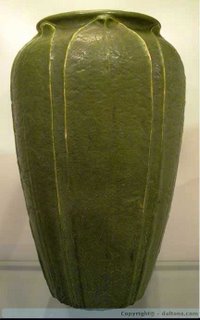 by livingstone and parry, a 1898 review from 'house beautiful' is quoted as saying, "the japanese have taught us much, but nothing more clearly perhaps than that beauty does not depend upon intricacy or elaborateness of design and ornamentation."
by livingstone and parry, a 1898 review from 'house beautiful' is quoted as saying, "the japanese have taught us much, but nothing more clearly perhaps than that beauty does not depend upon intricacy or elaborateness of design and ornamentation."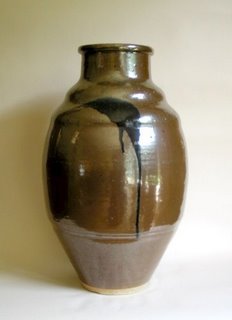 grueby pottery, seeing it as
grueby pottery, seeing it as 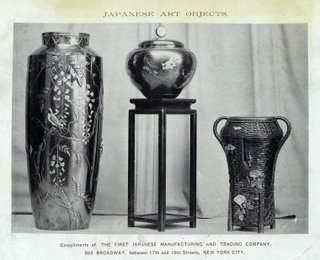 'japanesque,' and grueby pottery is simple, as was much pottery coming from japan. it still is.
'japanesque,' and grueby pottery is simple, as was much pottery coming from japan. it still is. any more simple than what was happening in the west, as the japanese print and the american magazine cover from the same time period illustrate.
any more simple than what was happening in the west, as the japanese print and the american magazine cover from the same time period illustrate.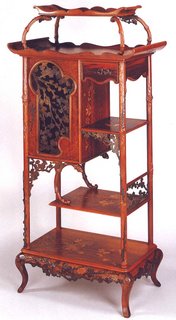 japonesque' was often far from simple.
japonesque' was often far from simple.Labels: comment, galle, grueby pottery, nancy